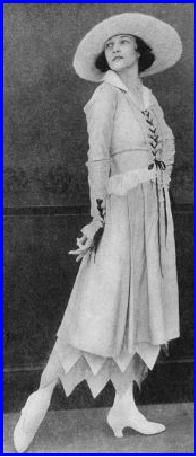 |
EIGHTEENTH CENTURY |
| << THE RENAISSANCE |
| WOMAN IN THE VICTORIAN PERIOD >> |

CHAPTER
XVIII
EIGHTEENTH
CENTURY
HE
eighteenth
century is unique by reason of
scientific discoveries,
mechanical
inventions and chemical achievements,
coupled with the
gigantic
political upheaval of the
French Revolution.
It
is unique, distinguished and enormously
fruitful. For example, the
modern frenzy
for
chintz, which has made
our homes burst into bloom
in endless variety, had
its
origin
in the eighteenth century
looms at Jouy, near Versailles,
under the direction
of
Oberkampf.
Before
1760 silks and velvets decorated
man and his home.
Royal patronage co-
operating
with the influence of such
great decorators as Percier and Fontaine gave
the
creating of beautiful stuffs to
the silk factories of
Lyons.
Printed
linens and painted wall
papers appeared in France simultaneously,
and for
the
same reason. The Revolution
set mass-taste (which is
often stronger than
individual
inclination), toward unostentatious,
inexpensive materials for
house
furnishing
and wearing apparel.
The
Revolution had driven out
royalty and the high
aristocracy who, with
changed
names
lived in seclusion. Society,
therefore, to meet the mass-desire,
was driven to
simple
ways of living. Men gave up
their silks and velvets and
frills, lace and
jewels
for cloth, linen, and sombre
neck-cloths. The women did
the same; they
wore
muslin gowns and their own
hair, and went to great length in
the affectation
of
simplicity and patriotic
fervour.
We
hear that, apropos of America
having at this moment entered
the great struggle
with
the Central Powers, simplicity is
decreed as smart for the
coming season, and
that
those who costume themselves
extravagantly, furnish their
homes
ostentatiously
or allow their tables to be lavish, will
be frowned upon as bad
form
and
unpatriotic.
These
reactions are inevitable,
and come about with the
regularity of tides
in
this
world
of perpetual repetition.
The
belles of the Directorate
shook their heads and bobbed
their pretty locks at
the
artificiality
Marie Antoinette et cie had practised. I
fear they called it sinful
art to
deftly
place a patch upon the face, or make a
head-dress in the image of a
man-of-
war.
Mme.
de Sta�l's familiar head-dress,
twisted and wrapped around
her head � la
Turque,
is said to have had its
origin in the improvisation of
the court
hairdresser.
Desperately
groping for another version
of the top-heavy erection, to
humour the
lovely
queen, he seized upon a
piece of fine lace and muslin
hanging on a chair at
hand,
and twisting it, wrapped the
thing about the towering
wig. As it happened, the
chiffon
was my lady's chemise!

We
begin the eighteenth century
with a full petticoat, trimmed
with rows of ruffles
or
bands; an overskirt looped back into
paniers to form the bustle
effect; the natural
hair
powdered; and head-dress of lace,
standing out stiffly in
front and drooping in
a
curtain behind.
It
was not until the whim of
Marie Antoinette decreed it
so, that the
enormous
powdered
wigs appeared.
Viennese
temperament alone accounts
for the moods of this lovely
tragic queen,
who
played at making butter, in a
cap and apron, over simple
muslin frocks, but
outdid
her artificial age in love
of artifice (not Art) in
dress.
This
gay and dainty puppet of
relentless Fate propelled by
varying moods must
needs
lose her lovely head at
last, as symbol of her
time.
PLATE
XXV
Mrs.
Vernon Castle in a summer
afternoon
costume
appropriate for city or
country and
so
adapted to the wearer's type
that she is a
picture,
whether in action; seated on
her own
porch;
having tea at the country
club; or in
the
Winter sun-parlour.
Mrs.
Vernon Castle in
Afternoon
Costume--
Summer
Table of Contents:
- A FEW HINTS FOR THE NOVICE WHO WOULD PLAN HER COSTUMES
- THE LAWS UNDERLYING ALL COSTUMING OF WOMAN
- HOW TO DRESS YOUR TYPE
- THE PSYCHOLOGY OF CLOTHES
- ESTABLISH HABITS OF CARRIAGE WHICH CREATE GOOD LINE
- COLOUR IN WOMAN'S COSTUME
- FOOTWEAR
- JEWELRY AS DECORATION
- WOMAN DECORATIVE IN HER BOUDOIR
- WOMAN DECORATIVE IN HER SUN-ROOM
- I. WOMAN DECORATIVE IN HER GARDEN:WOMAN DECORATIVE ON THE LAWN
- WOMAN AS DECORATION WHEN SKATING
- WOMAN DECORATIVE IN HER MOTOR CAR
- HOW TO GO ABOUT PLANNING A PERIOD COSTUME
- I. THE STORY OF PERIOD COSTUMES:II. EGYPT AND ASSYRIA
- DEVELOPMENT OF GOTHIC COSTUME
- THE RENAISSANCE
- EIGHTEENTH CENTURY
- WOMAN IN THE VICTORIAN PERIOD
- SEX IN COSTUMING
- LINE AND COLOUR OF COSTUMES IN HUNGARY
- STUDYING LINE AND COLOUR IN RUSSIA
- MARK TWAIN'S LOVE OF COLOUR IN ALL COSTUMING
- THE ARTIST AND HIS COSTUME
- IDIOSYNCRASIES IN COSTUME
- NATIONALITY IN COSTUME
- MODELS
- WOMAN COSTUMED FOR HER WAR JOB
- IN CONCLUSION